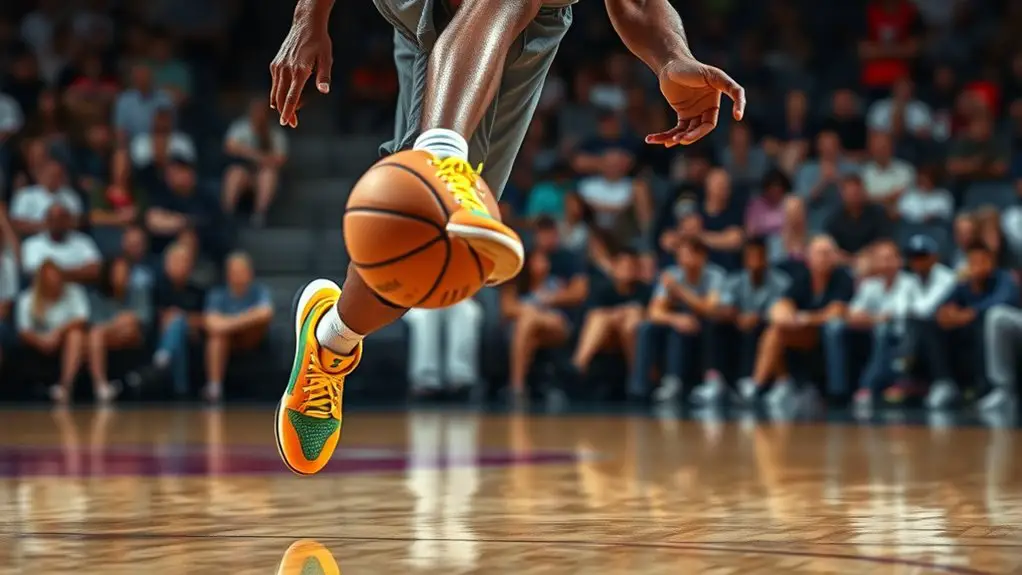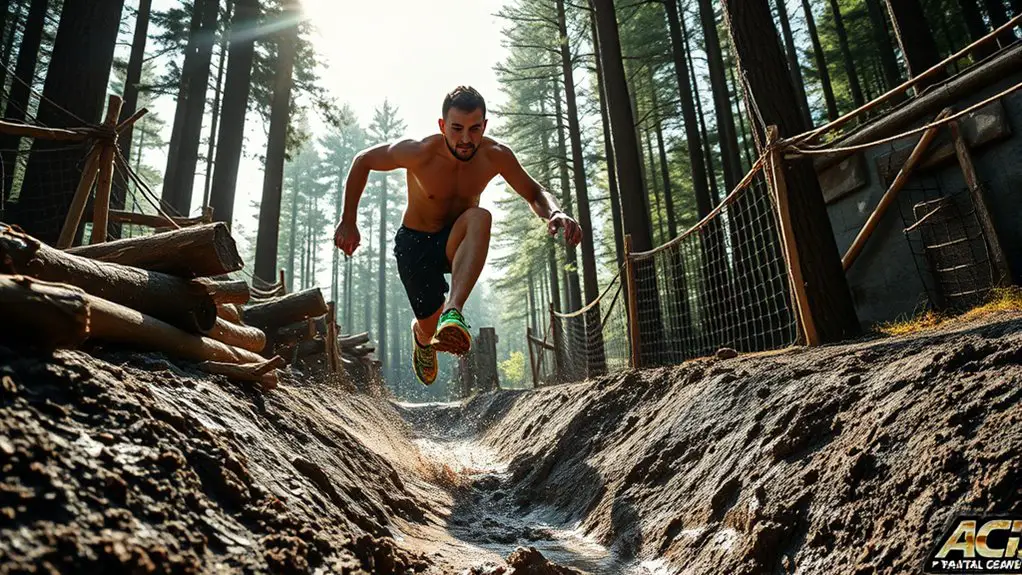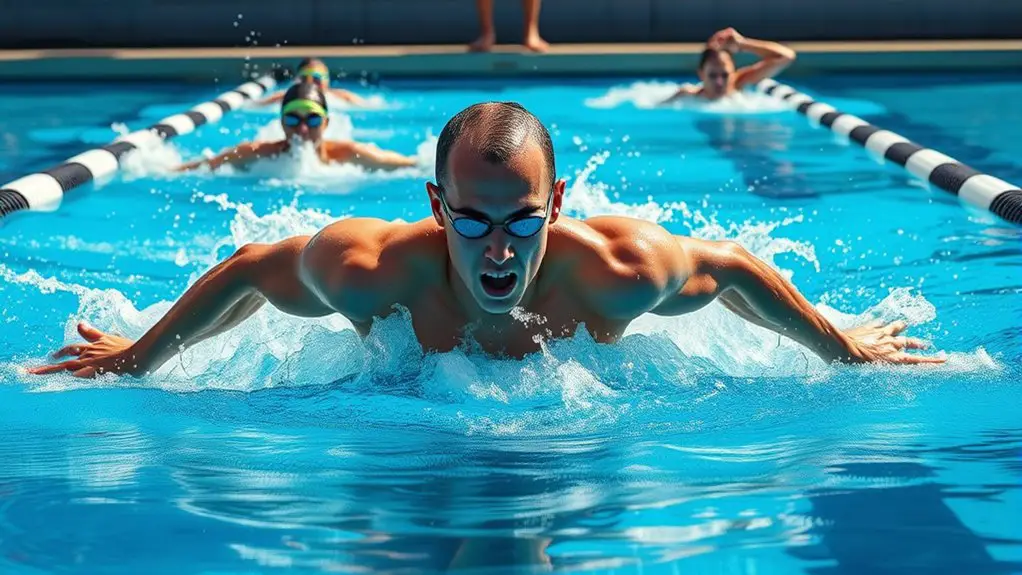Crossover dribbling speed hinges on biomechanics, momentum, and decision-making. By shifting your weight to create space and using quick foot placement, you can effectively outmaneuver defenders. Strong core stability and controlled movements enhance your balance, while being aware of your opponent's cues aids in timing your crosses. Practicing agility and visualization techniques builds confidence and sharpens your reflexes. If you want to master these techniques, stick around for deeper insights into improving your game.
Understanding the Crossover Dribble
The crossover dribble is one of basketball's most effective moves, and mastering it can elevate your game considerably. To really grasp this skill, you need to understand various crossover techniques that can confuse defenders and create space. Start with a low, controlled dribble that allows you to shift your weight seamlessly from one foot to the other. This shift is essential for executing effective dribble strategies.
Practice using both hands; being ambidextrous gives you an edge. When you make the crossover, try to sell the move by leaning into your fake. Keep your eyes up to read the defense and make quick decisions. Remember, it's not just about speed but also about timing and deception. With consistent practice, you'll find that your crossover dribble can become a powerful weapon on the court, allowing you to navigate around defenders and create scoring opportunities effortlessly. Additionally, mastering proper foot placement can significantly enhance your balance during the crossover, making it more effective.
Biomechanics of Movement
While mastering the crossover dribble, understanding the biomechanics of movement plays an essential role in enhancing your effectiveness on the court. By diving into kinematic analysis, you can break down how your body moves and responds during each dribble. It's all about the angles, timing, and coordination of your joints and muscles.
Force generation is key here; the power you create through your legs and core directly influences your speed and agility. As you plant your foot and push off, the mechanics of your movement determine how quickly you can change direction.
Pay attention to your body posture and weight distribution, as these factors affect your balance and control. When you're aware of these elements, you'll find yourself weaving through defenders with greater ease and confidence. Embrace this knowledge, and your crossover dribble will become an unstoppable force on the court. Additionally, incorporating squats and lunges into your training can significantly enhance your lower body strength and stability, providing a solid foundation for explosive movements.
The Role of Momentum
Mastering the crossover dribble isn't just about biomechanics; it also heavily relies on momentum. When you initiate the dribble, you're engaging in momentum transfer, allowing your body to harness kinetic energy effectively. This energy is vital as it propels you past defenders, giving you that edge you crave on the court. Incorporating squats and lunges into your training regimen can further enhance your explosiveness and stability during these movements.
| Action | Momentum Transfer | Kinetic Energy |
|---|---|---|
| Starting Position | Initial push | Stored energy |
| Crossover Movement | Shift weight | Energy in motion |
| Acceleration | Increase speed | Maximum efficiency |
| Change of Direction | Redirect momentum | Maintain speed |
| Finish the Dribble | Conclude movement | Release energy |
Understanding how to manipulate momentum can elevate your game. So, as you practice, focus on utilizing this powerful force to enhance your crossover dribble and enjoy the freedom it brings on the court!
Foot Placement and Balance
Effective foot placement and balance are essential for executing a successful crossover dribble. When you're dribbling, your foot positioning determines your agility and speed. Keep your feet shoulder-width apart for a stable base, allowing you to shift your weight quickly. As you prepare to make the crossover, lean slightly forward while maintaining that balance. Use balance techniques like bending your knees and staying on the balls of your feet; this keeps you light and ready to explode in any direction. A strong core provides enhanced stability that supports better control during rapid movements like a crossover.
Hand Coordination and Control
Since your hands play an essential role in executing a crossover dribble, having good coordination and control is fundamental. Great hand-eye coordination lets you maintain precision while dribbling, allowing you to manipulate the ball with finesse. It's all about those fine motor skills; the sharper they are, the smoother your moves become. Practice helps you refine these skills, so don't shy away from repetitive drills.
When you're in motion, the way your hands respond to the ball can mean the difference between a clean crossover and a turnover. Speed comes not just from your feet but also from the fluidity of your hands. As you work on your coordination, you'll find greater freedom on the court. You'll feel empowered to shake off defenders and create space. Remember, the more confident you are in your hand control, the faster and more dynamic your crossover will be. Additionally, incorporating agility ladder drills into your training can significantly enhance your foot speed and coordination, further improving your overall performance on the court.
Visual Perception and Decision-Making
When you're dribbling, your ability to perceive what's happening around you is essential. Quick reaction times and strong spatial awareness help you anticipate your opponent's movements, allowing you to make split-second decisions. Mastering these skills can greatly enhance your crossover dribbling speed. Additionally, practicing reaction time drills can further sharpen your reflexes and improve your overall performance on the court.
Reaction Time Importance
Although you might not realize it, reaction time plays an essential role in your ability to execute crossover dribbles effectively. When you're dribbling, every second counts. Your quickness in responding to defenders and shifting your weight can make or break your play. This is where reaction training comes into play. It sharpens your reflexes, allowing you to make split-second decisions with confidence. By incorporating drills focused on reflex improvement, you can enhance your agility and responsiveness on the court. You'll find that as your reaction time improves, so does your overall performance, giving you the freedom to outmaneuver opponents and create scoring opportunities. Embrace the challenge, and you'll enjoy the thrill of dominating the game with your newfound skills.
Spatial Awareness Skills
Spatial awareness skills are essential for any player looking to master crossover dribbling. To truly shine on the court, you need to develop your visual perception and decision-making abilities. Engaging in spatial awareness exercises can help sharpen your instincts, allowing you to read the game better. Think of cognitive mapping as a mental blueprint of your surroundings; it helps you track where players are and predict their movements. By honing these skills, you can create opportunities for yourself and your teammates, making your crossover move even more explosive. Remember, it's not just about speed; it's about knowing when and where to execute your dribble. Embrace these exercises, and you'll elevate your game to new heights.
Anticipating Opponent Movements
Anticipating opponent movements is an essential skill for any player looking to excel in crossover dribbling. By honing your ability to predict opponents' actions, you can create space and exploit their movement patterns. This skill hinges on visual perception and quick decision-making.
| Key Skill | Description | Impact on Game |
|---|---|---|
| Opponent Prediction | Reading cues from the defender | Enhances offensive plays |
| Movement Patterns | Recognizing typical defensive moves | Improves dribbling speed |
| Reaction Time | Quick responses to opponent actions | Increases scoring chances |
| Spatial Awareness | Understanding court layout | Maximizes play options |
Master these elements, and you'll find yourself maneuvering through defenses with ease, driving toward victory with every crossover.
Psychological Factors in Crossover Execution
When executing a crossover, your mental state plays an essential role in its success. Techniques to prepare mentally can boost your confidence, leading to better decision-making in the moment. Understanding how these psychological factors influence your performance is key to mastering the crossover dribble. Embracing a growth mindset allows you to view challenges during gameplay as opportunities for improvement, enhancing your overall execution.
Mental Preparation Techniques
Although mastering the crossover dribble relies heavily on physical skills, mental preparation plays a crucial role in executing it effectively. To elevate your game, try incorporating visualization exercises into your routine. Picture yourself on the court, effortlessly weaving past defenders with your crossover. This mental imagery can help you build the confidence needed to perform under pressure.
Additionally, engage in mental rehearsal. Run through the steps of your crossover in your mind, focusing on technique and timing. This practice not only sharpens your skills but also conditions your brain to react instinctively during a game. By embracing these mental preparation techniques, you'll enhance your overall performance and experience the freedom that comes from executing your moves with precision and confidence.
Confidence and Decision Making
Building on the mental preparation techniques you've practiced, confidence plays a significant role in executing your crossover dribble effectively. When you trust your skills, you'll find decision clarity in critical moments. Here are some tips for confidence building during your game:
- Visualize Success: Picture yourself nailing that crossover with ease.
- Practice Regularly: The more you drill, the more confident you feel.
- Stay Positive: Replace negative thoughts with affirmations about your abilities.
- Embrace Mistakes: View them as learning opportunities rather than setbacks.
Training Techniques for Enhanced Speed
To enhance your crossover dribbling speed, incorporating specific training techniques is essential. Start with speed drills that focus on quick footwork and explosive movements. Think about exercises like sprints and lateral shuffles that challenge your acceleration. You'll not only improve your overall pace but also develop the muscle memory needed for rapid changes in direction.
Agility exercises are equally important; they'll help you maneuver with precision during games. Incorporate cone drills or ladder workouts that encourage quick pivots and sharp turns. These routines will boost your coordination and control, allowing you to execute crossovers with flair and speed. Additionally, integrating strength training into your regimen will enhance your muscle power for directional changes.
Finally, don't forget to incorporate resistance training. Using bands or weighted vests can enhance your strength and explosiveness. By consistently practicing these techniques, you'll feel the freedom to break away from defenders and elevate your game. Stay committed, and watch your speed soar!
Analyzing Successful Crossover Moves
Successful crossover moves can be broken down into three key elements: timing, technique, and deception. Mastering these elements is essential for achieving crossover success on the court. To elevate your dribble technique and leave defenders guessing, consider these four factors:
Mastering timing, technique, and deception is crucial for executing successful crossover moves on the court.
- Timing: Execute your crossover at the right moment to catch your opponent off guard.
- Footwork: Use quick, precise steps to shift your weight effectively and create space.
- Body Language: Sell your move with convincing fakes to mislead the defender.
- Speed: Combine your dribble technique with explosive speed to drive past your opponent. Additionally, incorporating agility drills into your training can improve your quick footwork and overall effectiveness during crossover moves.
Frequently Asked Questions
What Are Common Mistakes to Avoid When Practicing Crossover Dribbles?
When practicing crossover dribbles, there are a few common mistakes you should avoid. First, don't neglect your hand placement; keep your dominant hand on top of the ball to maintain control. Also, pay attention to your body positioning; leaning too far forward can throw you off balance. Keeping your knees slightly bent and staying low will help you explode into the move, giving you the freedom to change direction swiftly and effectively.
How Can Nutrition Affect Crossover Dribbling Speed?
Did you know that athletes who optimize their nutrition can improve performance by up to 20%? To elevate your crossover dribbling speed, focus on carbohydrate timing—fueling your body with carbs before and after practice can boost energy levels. Also, don't underestimate hydration strategies; staying well-hydrated enhances your agility and reaction time. When you take care of your body, you're free to release your full potential on the court!
What Role Does Footwear Play in Dribbling Performance?
When you're dribbling, footwear plays a huge role in your performance. The right shoe technology can enhance your agility and responsiveness, giving you that freedom to move. Look for shoes with a solid traction design; they help you maintain control while making quick cuts. If your shoes grip the court well, you'll feel more confident, allowing you to focus on your game instead of worrying about slipping or losing your footing.
Can Age Impact a Player's Crossover Speed?
Yes, age can impact your crossover speed. As you get older, your body may not respond as quickly, but that doesn't mean you can't improve. Youth development plays a vital role; younger players often have more agility and quicker reflexes. However, with consistent training frequency, you can enhance your skills regardless of age. Embrace the journey, focus on your technique, and you'll find ways to maintain or even boost your crossover speed.
How Does Fatigue Influence Crossover Execution?
Imagine you're on the court, adrenaline pumping, but fatigue starts creeping in like a shadow. It's in those moments that your muscle engagement falters, and your crossover execution suffers. You can't push off the ground as explosively, and every dribble feels heavier. Recovery from fatigue is vital; without it, your moves lack the fluidity and precision you crave. Embrace your freedom on the court, but remember, fatigue can steal that away if you're not careful.




